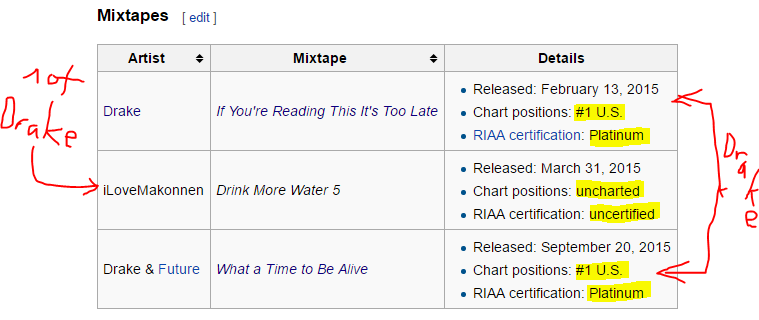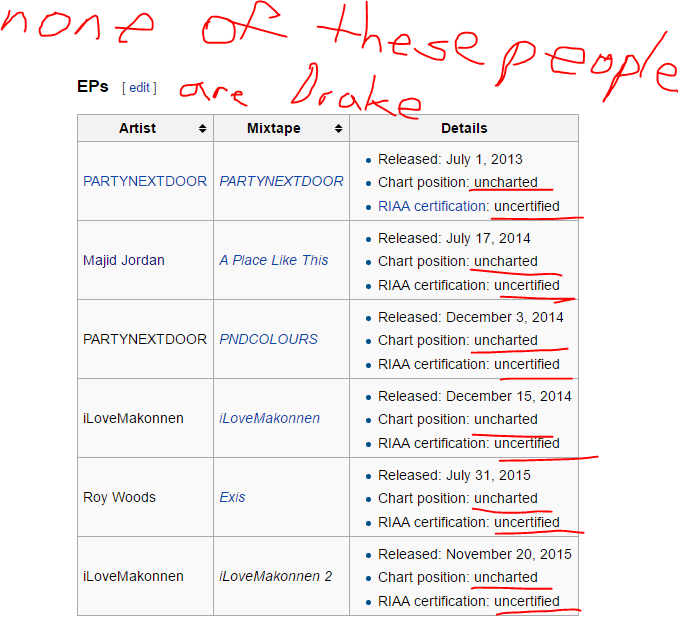On October 24th, his 30th birthday, notable gift giver and recreational ghostwriter solicitor Drake unloaded a set of new songs from his upcoming playlist project More Life, including “Fake Love“, “Sneakin’” and “Two Birds, One Stone“. Fans, hoping not to displease the rapper on his born day and risk putting him in his feelings, responded with verve. All three tracks have proven popular, covering most of Drake’s audience bases.
“Fake Love” is reminiscent of his hit song “Hotline Bling” and will likely prove a hit among popular audiences, while “Sneakin'” is a street-oriented track that features 21 Savage, the guy who’s best known for a song about “dingy ass hoes” who “don’t know how to be loyal”, which means he and Drake should get along well. Although “Two Birds, One Stone” is a single rapped verse and not likely to become a major hit, it’s provoked the most dialogue, as the track features an ill-humored diss directed at Kid Cudi, who recently checked himself into rehab, as well as an attack on coke rapper/Hillary supporter Pusha T.
In the midst of all of this, almost nobody stopped to ask: “What the hell is a ‘playlist project’?”
More Life, a title that refers back to an open letter/Instagram post Drake wrote in July as a response to the shooting of Alton Sterling, has been clarified as being neither an album nor a mixtape, which means that it’s something else entirely, yet apparently is still plain audio (as opposed to say, a visual album). Drake stated, “I want to give you a collection of songs that become the soundtrack to your life”, which, despite its vaguely totalitarian implications, seems to be the same goal Drake has already achieved in his music. His main appeal, which has made him the most popular rapper in the world, is his ability to be open and honest about his relationships, when most hip hop artists are still reluctant to be “soft”. But unless you feel so personally connected to Drake that you trust him to decide what you listen to on a daily basis, it sounds like More Life isn’t for you. And obviously that doesn’t seem to be his objective.
While Drake hasn’t clarified what a playlist project is, he has ensured that it will have “All original music from [Drake]” and that “You might hear some tunes from the family on there”. Now, blood relation has always been very important to Drake: he’s made songs dedicated to his mother and grandmother, and the mustachio-ed man featured on the More Life cover is his father, Dennis. Drake’s even made a song called “Keep the Family Close”. But as much as we all want to hear Dennis Graham sing 80s R&B, it’s unlikely that Drake actually means his literal family, but rather the family of collaborators he’s cultivated over the years, from his record label OVO Sound. In other words, More Life, in its dullest sense, might just be a compilation album so that Drake can promote his artists.
A label compilation, in a nutshell, is an album-as-sampler plate that showcases the various musicians on a label’s roster. Ideally, a high-profile musician, or several, serves to anchor the album, ensuring that audiences will give the album a listen and, hopefully, discover the next big artist. A young Drake himself benefited from the compilation treatment back in 2009, when he was featured prominently on the We Are Young Money compilation spearheaded by Lil Wayne, president of Young Money Entertainment (which Drake was and is still signed to). The two top ten hits from the album, “Bed Rock” and “Every Girl“, both featured Drake and charted concurrently with his breakout hit, “Best I Ever Had“. The same compilation made Nicki Minaj and Tyga visible to popular audiences and they too would prove to be successful, so clearly there’s some effectiveness to a compilation album. Or at least there was in 2009.
But this is only speculation. It’s entirely possible that More Life is not just an outlet for Drake to try to promote his artists by featuring them alongside his own music, although I believe it is. Beyond simply “paying it forward” by doing for others what Young Money did for him, Drake has the opportunity to cement his status and his finances by planting a long-term stake in the music business that can live beyond his lifetime as a performing artist. Thus, the title “More Life” – this project is an attempt at building a legacy. Birdman, the granddaddy of the YMCMB enterprise (his own label Cash Money owns Young Money) and a known rapper in his own right, has never had any of his own albums reach the success of Drake’s, but he still has a net worth of $110 million and he’s still making a cut of whatever money Wayne or Drake or Nicki or anybody under the YMCMB umbrella makes. In other words, respek. If Drake wants the kind of money where his grandkids’ grandkids can live off of his wealth, building up his label is a smart option.
Now, here’s the problem Drake is facing: he has a suspicious history with choosing and/or promoting his artists. Like, really bad. Bad enough that there’s an article written about it. There are five musical acts, not including Drake, who have been signed to OVO Sound. For fun, let’s take a look at what Wikipedia has to say about their musical success:



Have you noticed anything other than my horrid Paint skills (I still think I’m better than Drake)? OVO Sound hasn’t produced any artists near Drake’s caliber. The only one who has come remotely close to fame is PARTYNEXTDOOR, whose third self-titled project (wow, this guy really loves his name) reached #3 on the Billboard charts, albeit with a paltry 29,000 in album sales. For comparison’s sake, Drake’s own VIEWS album had been out since April and it still managed to beat out PND for the #2 spot that week. All of this is despite the fact that Drake has regularly promoted these artists through his OVO Sound Radio show on Apple Music (the same method by which he debuted the new songs on More Life), has made numerous guest features on their songs, and has even had them appear on his own songs. Majid Jordan was featured on Drake’s top 5 hit, “Hold On, We’re Going Home“, but even then they still couldn’t do half-decent numbers. iLoveMakonnen was the lead artist on “Tuesday” – Drake only hopped on the remix, which reached #12 on Billboard – and Makonnen still couldn’t even chart on his own?
Unsurprisingly, Makonnen left the OVO Sound label earlier this year, following an interview last December where he voiced displeasure with the way his music was being handled. When asked, “What’s your relationship with OVO like?”, he responded,”they put out my music and stuff and we just keep it moving. Let them tell you their relationship with Makonnen. I’m just an artist, being an artist, and there’s only so much that I can do.” The statement, like most of the interview, is completely jarring coming from the guy who’s most famous for making a song feels apathetic and defeated, like Makonnen was already emotionally checked out and prepared to leave the label. Earlier on in the interview, when asked about his experience of the music business, he says, “People aren’t as good as you thought they were”. It’s unclear whether he’s talking about Drake, but the numbers don’t lie. If you search up Makonnen’s “Tuesday”, half of the results mistake Drake for the lead artist.
The Weeknd, who wasn’t technically signed to Drake but garnered an early co-sign from him and a coveted appearance on “Crew Love“, stated in a Rolling Stone interview that he’d given Drake a handful of his own songs for Drake’s 2011 album Take Care – an album that has defined Drake’s musical style ever since. The Weeknd, who clarified that he had nothing bad to say about Drake, added the caveat, “You never know what I would say if this success wasn’t in front of me now”.
Drake has a terrifying history of sourcing his own music from lesser-known artists, some of whom get famous like The Weeknd, but many who aren’t reaping any benefits from associating with the biggest rapper on the planet, or Makonnen, who got used and then thrown away. “Hotline Bling” started off as a remix to D.R.A.M.’s “Cha Cha” before becoming its own song. D.R.A.M. didn’t see a dime from Drake’s massively-popular song, although he’s since rebounded and proven himself to be more than a one-hit wonder. But while his current single “Broccoli” is a euphemism for a certain green substance, many of Drake’s own artists aren’t getting any of the green that counts, while he’s racking up millions of streams and sales. Drake is currently poised to make another splash on the charts with “Fake Love”, a song criticizing people who smile in his face and try to take advantage of his success. But isn’t he doing the same thing by robbing promising artists – people he’s calling his “family” in public – of their own success before they can even enjoy it?
And this contradiction is why I’m skeptical, and even concerned about Drake’s playlist project. When he’s talking More Life, is he really talking More Drake? Is he actually serious about promoting his artists? And if he isn’t, he might be shooting himself in the foot. Drake just turned 30; he only has so long to start building up his music empire.
And on a scarier note, Drake has access to Apple Music’s streaming data. If he’s enabled to see what music Apple’s subscribers are listening to (specifically, what his own listeners might be listening to), he can cherry pick artists with moderate fanbases, listen to their songs before the public hears it, make his own version like he did with “Cha Cha”, and the public will accept it as his simply because he’s Drake. He’s authentic. He wouldn’t steal. He has feelings. In other words, your new favorite artist might be writing Drake’s next hit – and they don’t even know it yet.



Perfectly pent written content, thanks for selective information. “In the fight between you and the world, back the world.” by Frank Zappa.